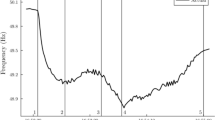Abstract
In this chapter, we study the consequences of an improvised nuclear detonation (IND) to the sub-transmission and distribution systems of Washington D.C. in the Eastern Interconnection (EI). We briefly discuss the geographical location of the blast and the interconnection of the power utility serving this area, with the neighboring power utilities. Analysis of the grid with respect to steady state stability as well as transient stability is performed to understand the impact of loss in load as a result of the blast. The steady state analysis alone does not offer a complete understanding of the loss of the neighboring substations. The transient stability analysis shows that for the simulated event, the system stabilizes approximately 7 s after the occurrence of the event. The stability of the system can be attributed to the fact that the drop in load was relatively small compared to the generation capacity of the EI.
Access this chapter
Tax calculation will be finalised at checkout
Purchases are for personal use only
Similar content being viewed by others
Notes
- 1.
The electric service provider companies and the generating stations names have been anonymized.
References
National Security Staff, Interagency Policy Sub-coordination committee for preparedness and response to Radiological and Nuclear threats. Planning guidance for response to a nuclear detonation (2010)
Barrett, C., Eubank, S., Evrenosoğlu, C.Y., Marathe, A., Marathe, M., Phadke, A., Thorp, J., Vullikanti, A.: Effects of hypothetical improvised nuclear detonation on the electrical infrastructure, In: Proceedings of the International ETG-Congress: Security in Critical Infrastructures Today, Germany, Berlin, November 2013
Buddemeier, B.R., Valentine, J., Millage, K.K., Brandt, L.D.: National capital region: key response planning factors for the aftermath of nuclear terrorism. Technical report, Lawrence Livermore National Lab (2011)
Wein, L.M., Choi, Y., Denuit, S.: Analyzing evacuation versus shelter-in-place strategies after a terrorist nuclear detonation. Risk Anal. 30(6), 1315–1327 (2010)
PSSE Transmission System Planning. http://w3.usa.siemens.com/smartgrid/us/en/transmission-grid/products/grid-analysis-tools/Pages/grid-analysis-tools.aspx
Kundur, P.: Power System Stability and Control. McGraw-Hill, New York (1994)
Acknowledgments
Authors thank members of the Network Dynamics and Simulation Science Laboratory for their helpful suggestions and comments. This work has been partially supported by DTRA Grant HDTRA1-11-1-0016, DTRA CNIMS Contract HDTRA1-11-D-0016-0001, NSF ICES Grant CCF-1216000, NSF NetSE Grant CNS-1011769 and DOE Grant DE-SC0003957. The content is solely the responsibility of the authors and does not necessarily represent the official views of the NSF, DOE and DoD DTRA.
Author information
Authors and Affiliations
Corresponding author
Editor information
Editors and Affiliations
Rights and permissions
Copyright information
© 2016 Springer International Publishing Switzerland
About this paper
Cite this paper
Barrett, C.L. et al. (2016). Impact of a Surface Nuclear Blast on the Transient Stability of the Power System. In: Panayiotou, C., Ellinas, G., Kyriakides, E., Polycarpou, M. (eds) Critical Information Infrastructures Security. CRITIS 2014. Lecture Notes in Computer Science(), vol 8985. Springer, Cham. https://doi.org/10.1007/978-3-319-31664-2_16
Download citation
DOI: https://doi.org/10.1007/978-3-319-31664-2_16
Published:
Publisher Name: Springer, Cham
Print ISBN: 978-3-319-31663-5
Online ISBN: 978-3-319-31664-2
eBook Packages: Computer ScienceComputer Science (R0)




